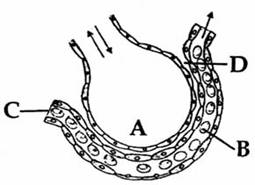NEET Breathing and Respiration Questions (MCQs) | Online MCQs test on Breathing and Exchange of Gases (Class 11) | Online MCQs Test no. 04
Human Respiratory System: MCQs Quiz - 4
Congratulations - you have completed Human Respiratory System: MCQs Quiz - 4.
You scored %%SCORE%% out of %%TOTAL%%.
Your performance has been rated as %%RATING%%
Your answers are highlighted below.
Question 1 |
Opening to the trachea is covered by a small flap of tissues termed as the ______.
Glottis | |
Trachea | |
Epiglottis | |
Larynx |
Question 2 |
The exchange of gases between inhaled air and blood is referred as ______.
Cellular respiration | |
External respiration | |
Internal respiration | |
Circulatory respiration |
Question 3 |
The maximum volume of air contained in the lung by a full forced inhalation is called
Vital capacity | |
Tidal volume | |
Total lung capacity | |
Inspiratory capacity |
Question 4 |
Aerobic respiratory pathway is also termed as ______ pathway.
Anabolic | |
Catabolic | |
Creatine phosphate | |
Amphibolic |
Question 5 |
The maximum volume of air that can be released from the lungs by forceful expiration after deepest inspiration is called the ______.
Total lung capacity | |
Vital capacity | |
Tidal volume | |
Ventilation rate |
Question 6 |
Which one is the cofactor of carbonic anhydrase?
Cu | |
Zn | |
Fe | |
Mg |
Question 7 |
The trachea divides into two smaller tubes called ______.
Bronchi | |
Trachea | |
Microtrachea | |
Eustachian tubes |
Question 8 |
Listed below are four respiratory capacities (a - d) and four jumbled respiratory volumes of a normal human adult
Which one of the following is the correct matching of two capacities and volumes?
Respiratory capacities |
Respiratory volumes |
(a) Residual volume |
2500 mL |
(b) Vital capacity |
3500 mL |
(c) Inspiratory reserve volume |
1200 mL |
(d) Inspiratory capacity |
4500 mL |
(a) 4500 mL, (b) 3500 mL | |
(b) 2500 mL, (c) 4500 mL | |
(c) 1200 mL, (d) 2500 mL | |
(d) 3500 mL, (a) 1200 mL |
Question 9 |
Inner surface of the bronchi, bronchioles and fallopian tubes are lined by
Cubical epithelium | |
Columnar epithelium | |
Squamous epithelium | |
Ciliated epithelium |
Question 10 |
Which one of the following statement is NOT correct regarding trachea?
It usually lies posterior to the muscular esophagus. | |
It splits into the right and left bronchi to supply air to the lungs | |
Opening to the trachea is covered by epiglottis. | |
Tracheal rings are C-shaped |
Question 11 |
Which one of the following statements is incorrect?
Tuberculosis is caused by a rod-shaped bacterium, Mycobacterium tuberculosis. | |
Tuberculosis is highly infectious and can be spread by airborne droplets. | |
Tuberculosis can't be treated by antibiotics | |
In Pulmonary Tuberculosis the elasticity of lungs is reduced. |
Question 12 |
Which one of the followings is NOT correct regarding Exhalation (expiration)?
Expiration is typically a passive process | |
Exhalation starts when the expiratory muscles relax | |
The elastic properties of the lung help to expel deoxygenated air during exhalation | |
During exhalation, elastic properties of the lung help to expel deoxygenated air |
Question 13 |
Which one of the followings is correct regarding larynx?
It prevents foreign objects from entering the trachea | |
It houses the vocal cords | |
It is an organ made of cartilage and connects the pharynx to the trachea | |
All of these are correct. |
Question 14 |
Which one of the following is a possibility for most of us in regard to breathing, by making a conscious effort?
One can consciously breathe in and breathe out by moving the diaphragm alone, without moving the ribs at all | |
The lungs can be made fully empty by forcefully breathing out all air from them | |
One can breathe out air totally without oxygen | |
One can breathe out air through eustachian tubes by closing both the nose and the mouth |
Question 15 |
The figure given below shows a small part of human lung where exchange of gases takes place. In which one of the options given below, the one part A, B, C or D is correctly identified along with its function?


B : Red blood cell - transport of CO2 mainly | |
C : Arterial capillary - passes oxygen to tissues | |
A : alveolar cavity - main site of exchange of respiratory gases | |
D : Capillary wall - exchange of O2 and CO2 takes place here |
Once you are finished, click the button below. Any items you have not completed will be marked incorrect.
There are 15 questions to complete.
Solve online NEET Biology Questions (MCQS) | A huge NEET Biology Question Bank is there with chapter wise NEET Biology questions



Tubercule bacilli is treated by anti t.b drugs which ARE antibiotics..
can you explain question 8 and 14 to me?
We will breath with both diaphragm as well as intercostal muscle
It is good job but I am not agree with you regarding Q.no 14 bcz it is not possible to breathe in or out without the action of intercostal muscles in voluntary breathing by using diaphragm only
intercostal muscles are supportive muscle for breathing,its not primary muscle,primary muscle is only diaphragm……and u can try this consciously, without moving your ribs u can breath and out